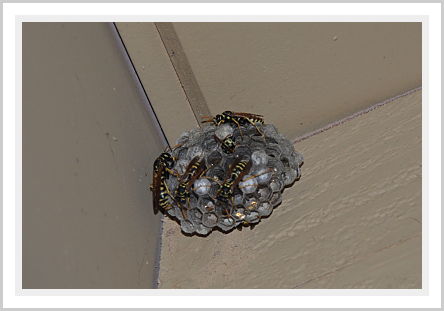I’m fascinated and disturbed by the wasp’s nest under the eaves. They picked a high-traffic area to set up house, right outside our back door. Two years ago they chose a similar spot, but I was able to remove the nest within a day. I annoyed two of them, but the nest was empty so they grudgingly relocated without a fuss.
This nest filled up quickly, with several adults keeping watch.
According to National Geographic:
“Despite the fear they sometimes evoke, wasps are extremely beneficial to humans. Nearly every pest insect on Earth is preyed upon by a wasp species, either for food or as a host for its parasitic larvae. Wasps are so adept at controlling pest populations that the agriculture industry now regularly deploys them to protect crops.”
I’m still trying to control the spread of scale and thrips in the front garden and imagine these wasps could help. Just yesterday I clipped away a few wheelbarrow loads of brown, stained under-growth from the thrips infestation. I moved on to the Magnolia to do battle with the remaining scale. The purchased lacewings emerged and presumable got to work, but the damaged leaves had to be removed.
Should the wasp’s nest stay or go? Further reading in an article from Purdue University suggests leaving the nest intact.
Most home owners do not realize that wasp nests are cleaned out each fall by the wasps themselves. The empty nests contain nothing but the outside paper shell at that time. This too will break down and disintegrate through the winter. Wasps never re-use the same nest from season to season, so letting mother nature take care of them through time, is usually the best control method we have.
For now, that’s exactly what we plan to do.
•More about wasps from National Geographic.
•Leaving the nest: a perspective from Purdue University Plant and Pest Diagnostic Lab.

